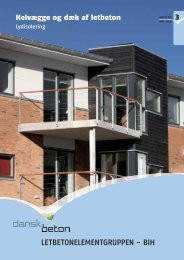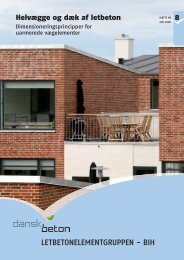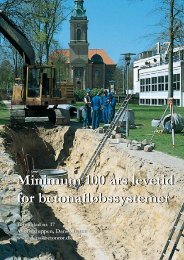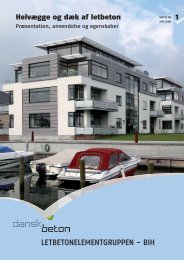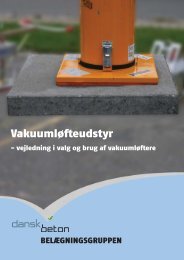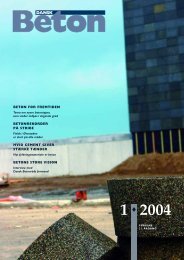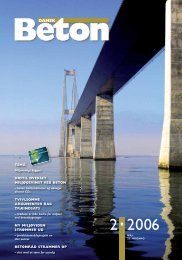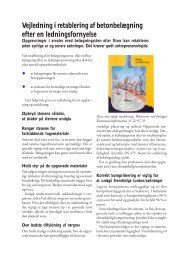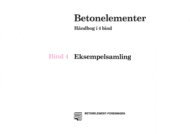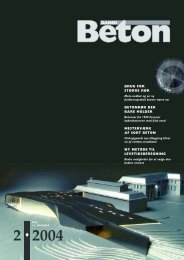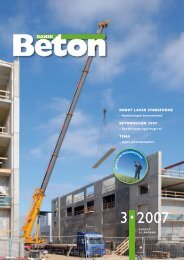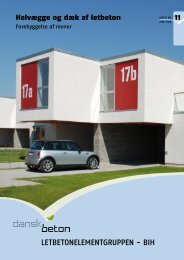Concrete Credentials: Sustainability
Concrete Credentials: Sustainability
Concrete Credentials: Sustainability
- No tags were found...
Create successful ePaper yourself
Turn your PDF publications into a flip-book with our unique Google optimized e-Paper software.
CONCRETE CREDENTIALS: SUSTAINABILITYOVERVIEWThe concrete industry consists of nine sectors:cement, aggregates, admixtures, groundgranulated blast furnace slag (ggbs), fly ash,mortar, ready-mixed concrete, precastconcrete and steel reinforcement. In 2008,the UK concrete industry embarked on theimplementation of a sustainable constructionstrategy. This agreement to a number ofsustainability objectives included thecommitment to produce an annual report ofthe industry’s sustainability performance.The individual sectors and companies hadalready established initiatives and reportingstructures. The commitment to a comprehensiveindustry strategy has required further developmentof sector and company processes and this willcontinue as the framework is developed andrefined. In addition, the industry performanceindicators were developed to support the UKGovernment’s sustainable construction strategy.In March 2009 the industry published itsfirst report.In March 2010 the concrete industry publishedits second performance report. This signifiesanother key milestone for the concrete industry,leading other material sectors by publishingsustainability performance targets. With 12targets published and more in development,this reflects the industry’s commitment totransparency and continual improvement.For a full list of targets visitwww.sustainableconcrete.org.ukCover Image - Joseph Chamberlain School, Birmingham.This post-tensioned concrete-framed school achievedtop marks from the Prime Minister for inspiration indesign. <strong>Concrete</strong> provides environmental, social andeconomic advantages for school designAccurate information about the sustainablebenefits of concrete is essential to inform thecollaborative effort needed to make any newbuild or refurbishment/upgrade projectsustainable, both in construction andoperational use. The quick reference tableswithin this document present the performancebenefits of concrete in a format for designers toeasily interpret the sustainability credentials.The product and material data provided in thispublication is sourced from the concrete industry’ssecond report and specific sector reporting.RESPONSIBLE SOURCING ANDLOCAL PRODUCTIONThe concrete industry has already takensignificant steps to achieve and exceed the UKGovernment Sustainable Construction Strategytarget that at least 25% of construction materialsshould be supplied from suppliers withresponsible sourcing certification by 2012. Forthe latest information on what products havecertification visit www.greenbooklive.comThe concrete industry is the first industry tolink its sustainable construction strategy to theresponsible sourcing standard developed bythe Building Research Establishment (BRE), BES6001 - “Framework Standard for the ResponsibleSourcing of Construction Products”. The localnature of concrete’s production and the wellintegrated supply chain has been an advantagefor concrete companies to gain accreditation.Designers can now easily source accreditedmaterial and gain maximum credits insustainability assessment tools such as the Codefor Sustainable Homes and BREEAM.<strong>Concrete</strong> is the local material and this leads tosocial, economic and environmental benefits; forexample, local skills development, localemployment and local accountability forenvironmental impacts. Over 33,000 peopleare directly employed in the UK concreteindustry. The concrete industry is committed toengaging with and supporting localcommunities and 86% of relevant sites havecommunity liaison activities.The average delivery distance of ready-mixedconcrete to the construction site is just eightkilometres, and just over 150 kilometres forprecast concrete products.The average road delivery distance foraggregates is only 38 kilometres. 50 per cent ofready-mixed concrete plants are located at theaggregate extraction site helping to reduce theimpact of transportation.WASTE AND MATERIALEFFICIENCYThe concrete industry diverted over 5 milliontonnes of material from the waste stream andused them in place of primary materials. Wasteis used as a source of fuel and also used inconcrete manufacture. By-products from otherindustries, such as fly ash from power stations andggbs from the iron industry reduce demand onprimary materials and also reduce theembodied CO 2of concrete, when used asadditional cementitious material. For detailedestimates of the CO 2emissions associated withan ‘average’ tonne of concrete, suitable for use ina carbon calculator, which also include data forwater and steel reinforcing bar, visitwww.sustainableconcrete.org.ukResearch shows that virtually all the recycledaggregates in the waste stream are alreadybeing re-used, and have replaced around 25%of virgin aggregate use. This is the highest levelachieved amongst all European Countries.ENERGY AND CO 2The energy-intensive sectors in the industry havea well-established record of reducing carbonand greenhouse gas emissions. The cementsector has improved its Climate ChangeAgreement performance by 33.7% between1990 and 2008, exceeding the agreement target.The ground granulated blast furnace slag sectorhas achieved a 19% energy reduction between1999 and 2008.As well as the energy used in product manufactureand construction (embodied/embedded) themore significant energy use is in the operationof our homes and buildings. Residential buildingsalone are responsible for 27 per cent of UKCO 2emissions.The thermal performance properties of concreteas a construction material can provide considerablein-use (operational) energy savings over the lifetimeof a building. In housing for example, thisoperational energy saving can offset the slightlyhigher embodied CO 2associated with concreteand masonry homes within a decade of use. Tofind out more visit www.concretecentre.com




